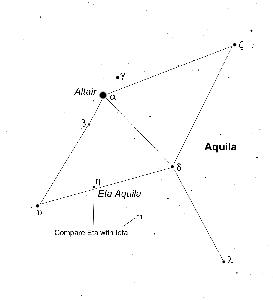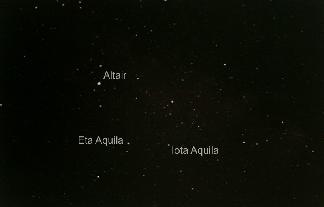Aquila
Altair, Aquila's brightest star is the most southerly of the three stars that make up the summer triangle so, not surprisingly, Aquila is best observed in late summer or autumn. It contains one A-list object, Eta Aquila - the first Cepheid variable star to have been discovered.
Eta Aquila Cepheid Variable Star E B M
Eta Aquila lies eight degrees (one and a half binocular fields) directly south of Altair. It is a bright Cepheid variable that varies in magnitude from 4.5 to 3.7 with a period of 7.2 days. Its variability was discovered by the English astronomer Edward Piggot in 1783. Try and observe it over a period of time and compare its brightness with Iota (?? Aquila 4 degrees away. (For northern observers put ? Aquila at the upper left of a binocular field and ? Aquila will be at the lower right - the opposite for southern observers) ? Aquila has a magnitude of 4.36, so at minimum ? Aquila will be slightly less bright than ? (but probably not noticeably so), but at maximum it will be obviously brighter.
Soon afterwards, Piggot's deaf mute neighbour, John Goodricke, discovered a second star, called d Cephei, which varied in a similar way. These stars, which are some of the intrinsically brightest in the heavens, are slightly unstable and oscillate in size and brightness with a very regular period. They became known as Cepheid variables and have played an important role is measuring the size of the Universe. Early in the last century an American astronomer, Henrietta Leavitt, discovered that the period of these stars varied in proportion to their absolute brightness. As they are very bright, they could be seen in quite distant galaxies. So by simply measuring their periods their absolute brightness could be found and hence the distance to the galaxy in which they are located. Observations of Cepheid variables in remote galaxies by the Hubble Space Telescope have provided one of the best measurements of the scale size of the Universe to date.
Position: 19h 52.5m +01deg 00min





